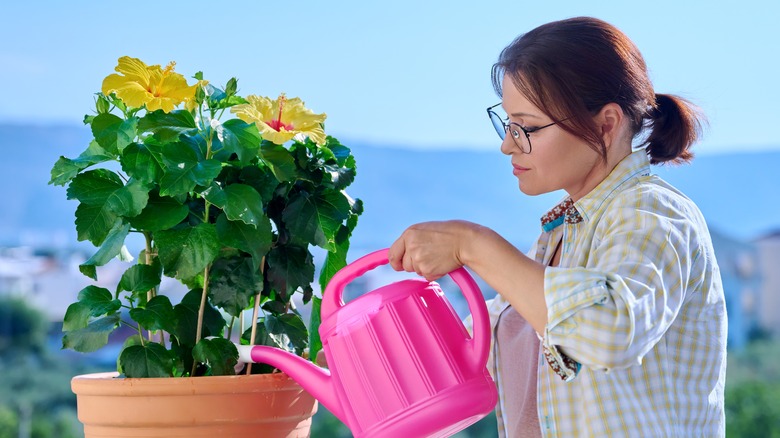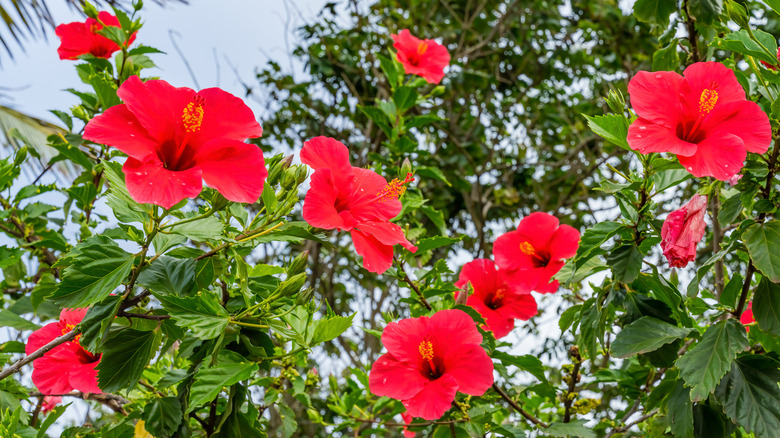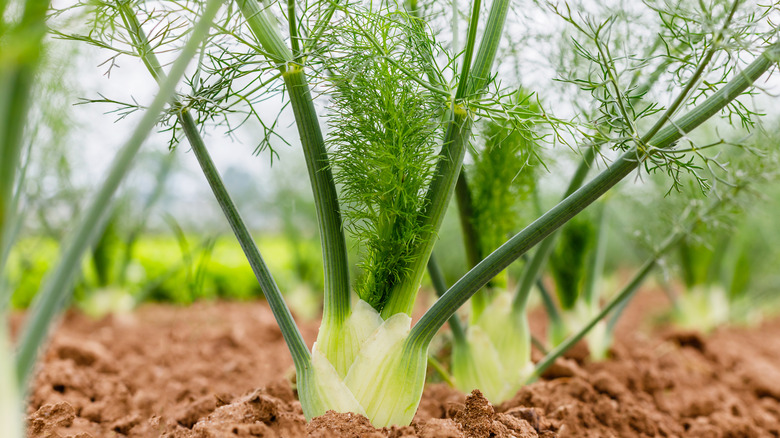The Tropical Flower That Is An Excellent Companion For Fennel
A popular addition to herbal teas and medicines, fennel is an easy-to-grow household crop with a fragrant aroma that offers many health benefits for the people who consume it. However, the flowering herb is a known fiend to many vegetable crops because of its inherent allelopathic properties. Gardeners and horticulture specialists recommend growing fennel separately from other plants in order to prevent the crop from stunting or killing its neighbors with its allelopathic chemicals. But if you're looking to fill space in your garden already dominated by fennel, hibiscus may be the solution you're looking for. Fennel and hibiscus can serve as great companion plants due to their shared growth and survival needs.
Also a common ingredient added to herbal teas for its healing abilities, hibiscus is a low-maintenance plant that produces large blossoms in many vibrant colors throughout the mid- to late-summer months. With historical ties to several countries in Africa and Asia, these tropical blooms take on many names across the various cultures in which they are cultivated, and it's this versatility that makes hibiscus flower plants apt to grow around a plant as unfriendly as fennel. Additionally, various research studies from the past decade have suggested that certain species of hibiscus may exhibit allelopathic properties of their own, which may offer an additional reason as to why the flowers are capable of growing near fennel.
Why hibiscus grows well with fennel
A significant factor behind hibiscus and fennel's potential to make a successful pair of companion plants is the similarity in the two crops' growing conditions. Hibiscuses, for example, can be found all over the world thanks to their versatility and low-maintenance nature. Generally, hibiscus plants enjoy copious amounts of sun throughout the day and soil that drains well, making the flowers well-versed in tropical climates like those seen in Mexico, Thailand, African countries like Sudan and Nigeria, and some parts of China. Comparably, fennel also enjoys basking in the sun during daylight hours and needs well-draining soil due to its disdain for wet feet. Both plants may reach impressive heights if left to grow unobstructed, with hibiscus shrubs capable of growing up to around 10 feet tall, and fennel typically growing up to 6 feet tall.
The defining characteristic that hinders fennel from growing well alongside other mainstream garden crops is its allelopathic ability, a natural form of self-defense that has aided in the development of synthetic herbicides. The herb, like some species of trees, can release chemicals into the soil capable of stunting the growth of and even killing certain plants located close by. However, hibiscus plants may contain their own share of allelochemicals. According to a 2015 study published in Natural Product Communications, Hibiscus sabdariffa, a red-flowering species belonging to the genus Hibiscus, may exhibit allelopathic properties that, in large concentrations, help restrict root growth in other plants.
How to grow fennel and hibiscus together
When growing fennel and hibiscus in tandem, try to keep conditions similar. Make sure both plants are regularly watered, have unrestricted access to sunlight, and are planted in slightly acidic soil. Fennel is more drought-resistant than hibiscus, but refrain from depriving your crops of water for too long or oversaturating your soil to the point of not giving it time to absorb between applications. Fennel also needs ample room to grow to its full size without restrictions, so measure at least 1 foot of space between any plants and their neighbors, whether they be hibiscuses, more fennel, or any others that complement the herb.
When deciding on additional companion plants, note that fennel is especially harmful to nightshade breeds, including tomatoes, peppers, and potatoes. Also, avoid planting fennel too closely to other members of the Apiaceae family out of concern that the crops may cross-pollinate and negatively impact the flavor of each plant. Common Apiaceae species include celery, carrots, and popular herbs dill, caraway, and parsley.
Hibiscuses require little care to blossom successfully and despite their allelopathic properties, a wide variety of plants would fare well growing next to them. Though, this plant is most commonly paired with other flowers, particularly those that call for similar environmental conditions. Possible companion plants for hibiscuses include daylilies, crepe myrtles, irises, and poppies, all of which are fond of well-draining soil and ample sunlight and ultimately fare best in tropical climates.


